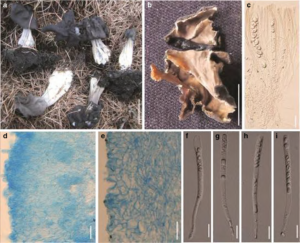Helvella pseudolacunosa Q. Zhao & K.D. Hyde, in Ariyawansa et al., Fungal Diversity 75: 142 (2015)
Index Fungorum number: IF551446; Facesoffungi number: FoF00971;
Diagnosis – Pileus has a grey to dark grey, pinched hymenium, margin fused with stipe in several places, and a creamy, glabrous sterile surface. Stipe is enlarged at base, rounded longitudinal ribs, near the base with enlarged deep furrows, grey-white.
Etymology – Named because of the resemblance with Helvella lacunosa.
Holotype – CHINA, Neimenggu Province, Axiangshan County, alt. 180 m, 16 August 2013, Qi Zhao 2012 (HKAS 87594, GenBank number: KR 493476). Symbiotic in the coniferous forests of Larix gmelinii (Rupr.) Rupr. or Pinus koraiensis Sieb. et Zucc. Sexual morph: Pileus saddle-shaped to irregularly lobed when young, irregularly lobed or brain-like when maturity, 1–4 cm high, 2–3 cm broad, pinched at apex, margin fused with stipe, hymenium glabrous, grey to dark grey, becoming black when dried, sterile surface glabrous, creamy, becoming yellowish when dried. Stipe 2–8 cm long, 0.7–1.5 cm broad, enlarged at base (up to 3 cm), round-shaped longitudinal ribs, near the base with enlarged deeply furrows, glabrous, grey-white when young, becoming grey with age, sometimes ochraceous along the upper portions of the stipe, white mycelium at base. Medullary excipulum 180–260 μm broad, textura intricata, hyaline, hyphae 3–5.5 μm broad, walls thickened. Ectal excipulum 120–220 μm broad, hyaline, terminal cells 16–40×10–20 μm, blue in cotton blue. Stipitipellis 40–55 μm, hyaline, composed of enlarged parenchymal cells, terminal cells 14–30×8–12 μm, walls thickened, blue in cotton blue. Asci 230–280× 13–20 μm, pleurorhynchous, 8-spored, subcylindrical to clavate, blue in cotton blue. Ascospores [H2O] (14.5)15–19.5(20)×(9.5)10–12(12.5) μm [x = 17.5× 11 μm n=40], ellipsoid, smooth. Paraphyses filiform, 3–4.5 μm broad, slightly exceeding the asci, brown, with a yellow refractive content in Melzer’s reagent, blue in cotton blue; apex 3.5–5 μm broad. Asexual morph: Undetermined.
Material examined – CHINA, Jilin Province, Antu County, alt. 200 m, 26 August 2006, B. Tolgor 4533 (HMJAU 4533 holotype).
Notes – The genus Helvella (Helvellaceae, Pezizomycotina) is regarded as common macrofungi in most temperate forests, and have been widely reported from Europe, North America, Asia and Australia; very little is known about the trophic status of these fungi (Abbott and Currah 1997; Hwang et al. 2015). Identification of the species belonging in this genus has often been based on ascoma shape and colour and the presence or absence of projecting hyphae on the sterile surfaceof the apothecium (Abbott and Currah 1997; Dissing 1966; Hwang et al. 2015;Weber 1972). There are 476 epithets listed under Helvella (Index Fungorum 2015), but few molecular data are available in GenBank (Landerose and Korf 2012; Nguyen et al. 2013). Based on phylogenetic analyses and morphological comparison, our isolate belongs to H. lacunosa complex in Helvellaceae (Fig. 70). Helvella pseudolacunosa is similar to H. dryophila N.H. Nguyen & Vellinga, H. lacunosa Afzel.: Fr and H. vespertina N.H. Nguyen& Vellinga (Fig. 71). However, H. dryophila differs from H. pseudolacunosa in having a dark, almost black, squat pileus, light stipe, and forms ectomycorrhiza with Quercus species (Nguyen et al. 2013). Morphological differences between H. pseudolacunosa and H. lacunosa are subtle, the stipe of H. pseudolacunosa is usually enlarged at base, with rounded, longitudinal ribs, grey-white when young, ochraceous along the upper portions, while the latter species generally has a sharp-edged ribs, inside of stipe with longitudinal chambers, pale greyish to greyishbrown to nearly black (Dissing 1966). Helvella vespertina differs from H. pseudolacunosa by its pileus, three-lobes and wavy, gigantic stipe, and in forming ectomycorrhiza associations with conifers (Nguyen et al. 2013).

Fig. 1 Helvella pseudolacunosa (holotype) a Typical mature specimens b, d Sterile surface of pileus c Asci and paraphyses e Stipitipellis f–i Asci. Scale bars: a=2 cm, b=0.5 cm, c–i=30 μm
